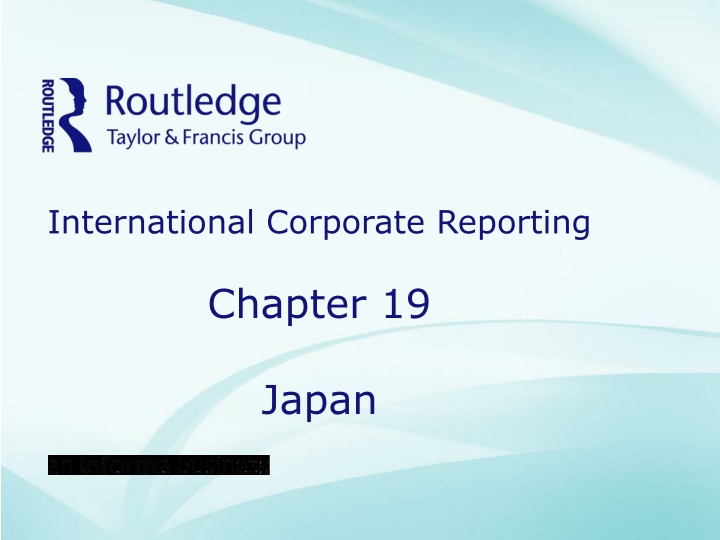
Corporate Reporting in Japan: Insights into Business Structure, Institutions, and Accounting Regulation
Explore the unique aspects of corporate reporting in Japan, including the influence of government regulations, business structures like Keiretsu, legal and financial institutions, external influences, historical relationships with IASB, and the challenges of IFRS convergence.
Download Presentation

Please find below an Image/Link to download the presentation.
The content on the website is provided AS IS for your information and personal use only. It may not be sold, licensed, or shared on other websites without obtaining consent from the author. If you encounter any issues during the download, it is possible that the publisher has removed the file from their server.
You are allowed to download the files provided on this website for personal or commercial use, subject to the condition that they are used lawfully. All files are the property of their respective owners.
The content on the website is provided AS IS for your information and personal use only. It may not be sold, licensed, or shared on other websites without obtaining consent from the author.
E N D
Presentation Transcript
International Corporate Reporting Chapter 19 Japan
Business structure Government regulates business Keidanren (employers federation) influences legislation for business Holding companies prohibited 1946 Keiretsu are large groups, interlocking but with loose links Cross-holdings more important than majority holdings
Institutions Legal system code law. Taxable income historically linked to accounting income. Strong stock market, strong bank finance. Stress on long-term value, not dividends. Profession: JICPA relatively small but growing accountants are trained within employment.
External influences Early 20th century, European influence French, German, British. After second world war, US influence created Securities and Exchange Law, JICPA and BADC, all influencing current structure, subsequently modernised.
Accounting regulation Since 2001, ASBJ responsible for development and deliberation of accounting standards in Japan. ASBJ is private sector standard-setting board, operates under FASF. All accounting standards set by ASBJ are endorsed by Financial Services Agency (FSA).
Historical relationship to IASB Founder member of IASB Japanese accounting rules have not been greatly influenced by IAS/IFRS Standards From 1999 the Japanese standard setters started working closer to IAS/ IFRS Standards Evidence of IFRS Standards in some group accounts
Reluctance to apply IFRS 2004 METI study group discussed arguments for and against aligning Japanese standards with IFRS Standards. Suggested: Do more to raise external awareness of Japanese accounting standards Retain local solutions for local needs
Problems with IFRS convergence Banks dislike fair value accounting for derivatives. Companies prefer to retain uniting of interests accounting as well as having acquisition accounting. Pension liabilities recognised over longer periods than IAS 19 allows. Feeling of being pressured into accepting IASs.
Recognising need for IFRS 2007 European stock exchanges recognised overseas listed companies if IFRS Standards were used. 2007 Tokyo Agreement between ASBJ and IASB to work toward convergence. 2011 Convergence largely completed. Japanese GAAP not identical to IFRS Standards but deemed equivalent in EU markets.
Current position Four sets of accounting standards may be used: IFRS Standards (called Designated IFRS , designated by FSA of Japan). Japanese Modified International Standards (JMIS) Japanese Accounting Standards (Japanese GAAP) US GAAP (declining in use) Political mood is to promote increasing use of IFRS
Business combinations Prior to 1960s no consolidated accounts. US market insisted on group accounts for US listing. Early rules were compromise and allowed exclusions of subsidiaries if not material. 1999 closer alignment with IAS Standard, concept of control, more information about group. METI 2004 concerned that IFRS Standards did not allow uniting of interests method. Also concerned that amortisation of goodwill is not permitted. Both regarded as closer to economic reality of Japan.
Narrative reporting 2015 Corporate governance code encouraged reporting principles of value creation and ESG. 2017 METI issued guidance on integrated disclosure Values Business model Sustainability/ growth Strategy Performance and key performance indicators Governance
Auditing CPA audits must apply Japanese GAAS: Auditing standards issued by the BAC Statements issued by the JICPA Business Advisory Council (BAC) is an advisory body within the FSA (i.e. an element of state control). BAC requests JICPA to develop and implement auditing standards, issued by BAC. Aim is convergence with ISAs and ISQC 1.
Corporate governance Three governance systems: Companies with an Audit and Supervisory Board (kansayaku). Companies with Three designated committees (nomination, remuneration and audit). Companies with an Audit and Supervisory Committee. 2018 Corporate Governance Code of TSE refers to all three forms.
Governance issues Kansayaku has limited powers and so causes concern to foreign investors. (Challenge of local culture versus international expectations in governance.) More disclosures and explanations are required for cross-shareholdings in keiretsu. Accounting-related frauds have attracted international attention to weak internal controls and corporate culture of loyalty.
Research examples Survey investigation 2015 IFRS adoption report- issues and challenges Measuring multinationality Growing number of Japanese firms becoming trans-regional and global. Banks and corporate clients Investigating relationship between bank influence and earnings management External pressures Pressures towards Anglo-American model of corporate governance
